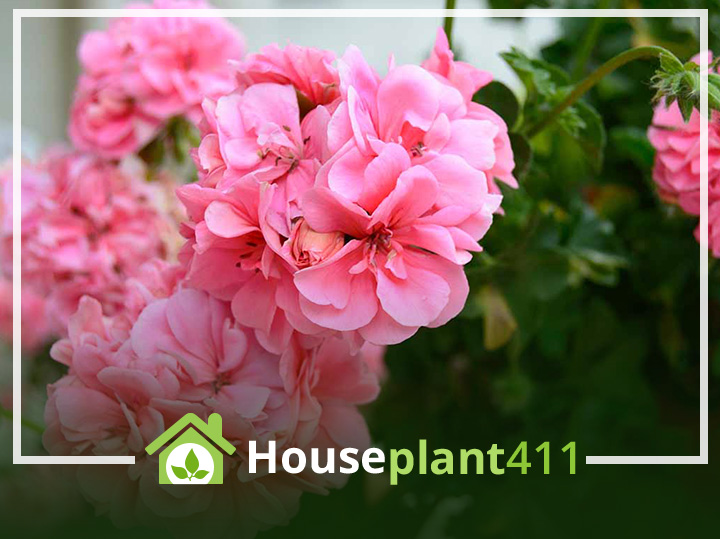Geraniums are one of our most popular outdoor plants; and they make great indoor flowering plants once the weather turns cold. The plants we call Geraniums are really part of the genus Pelargonium which means “stork” in Latin. There are over 200 Pelargonium species, most of them originally from South Africa. Geraniums come in a variety of colors, white, pink, salmon, red, fuchsia, lavender, leaf patterns, round, segmented, lacy, flower size, single or double blooms, and leaf color, green, green and white, or multicolored. They can be a compact upright plant or a graceful hanging vine. The vibrant flowers don’t have an appealing aroma, but there are several varieties that have leaves with lovely scents. Geraniums are a great addition to your indoor and outdoor plant collection, but will bloom indoors only if you keep them in very bright light or direct sun.
There are several different types of geraniums:
Common Geranium (Pelargonium x hortorum): These are compact plants that are often sold as bedding plants. Their leaves have distinct bands or zones in a darker color, tri-colored leaves, or silver or white areas that give them the nickname “zonal geraniums.” Common geraniums have single or double blooms that come in pink, white, red, and salmon.
Ivy- leaved geranium (Pelargonium peltatum): This type of geranium has smooth leathery, ivy shaped leaves and grows as a cascading vine. It looks great in a hanging basket. The flowers have narrow petals and the blooms are less showy and dense than those of the common geranium.
Martha Washington (Regal) Geranium (Pelargonium x domesticum): These geraniums have woody stems, wrinkled leaves with pointed lobes, and the brightest flowers of all of the geranium varieties. The blooms can range from a dramatic purple black to a bright yellow. Martha Washington’s are mainly grown in commercial greenhouses as potted plants. They are not very heat tolerant and do not do as well outdoors as the Common or Zonal geranium.
Scented–leaved Geranium: There are numerous varieties of scented geraniums all with different types of leaves and growing habits. The flowers are usually smaller and less showy than other types of geraniums. The leaves can be used to make sachets, tea, and potpourris. Here’s a list of some of the scents geraniums can produce: Almond, Apple, Coconut, Lemon, Nutmeg, Old Spice, Peppermint, Rose, and Strawberry.
Geranium Care Instructions: Don’t fret too much over your geraniums: bright light, not too much water, quickly removing dead flowers are the main things to keep in mind. These are the care instructions that have worked for me.
Light: Indoors, Geraniums can grow if placed in moderate light, but only bloom in very bright intense light. Fluorescent lights about 10 to 12 inches from the plants can be used to supplement natural light. Outdoors, place geraniums in very bright light or direct sunlight.
Water: Geraniums easily survive being under watered, and in fact often bloom more when stressed with a little bit of a drought. Too much water on a consistent basis causes root rot and the plant dies. Wait until the top 50% of the soil is dry before watering, but never allow the whole root ball to dry out.
Fertilizer: Fertilize every two weeks in the spring and summer when the plant is actively growing with a water-soluble houseplant fertilizer high in potassium at ½ the recommended strength. The potassium helps the flowers develop.
Temperature: Geraniums like it on the cool side, 65-75 degrees during the day, and around 55 at night, though they seem to adapt to warmer temperatures without much difficulty. Avoid cold, drafty areas.
Humidity: The common Geraniums we find in the stores are not fussy about humidity. However, very high humidity encourages bacterial and fungal growth on the leaves and stems and very low humidity encourages spider mites.
Flowering: Geraniums need very bright intense light to bloom. Personally, I’ve found that if I go away on vacation and my geraniums dry out more than usual, once I water again, they bloom more than ever. Quickly remove fading flowers. geraniums produce a lot more flowers if you’re really consientious about doing this.
Pests: Aphids, whitefly, and spider mites all seem attracted to geraniums. When you put your geraniums outside for the spring and summer, be careful the caterpillars don’t start enjoying them for dinner.
Diseases: Bacterial leaf spot, gray mold, blossom blight, or rust can develop whe the humidity is too high or the leaves are kept wet. This is one of the reasons I never recommend misting plants.
Soil: The right soil is very important if you want your geraniums to grow. Use a quick draining all-purpose loose houseplant potting mixture that contains a fair amount of nutrients if you’re putting your geraniums into pots. If you’re planting Geraniums outside in the garden, be sure to add a little sand and compost to the soil if it seems heavy and clay-like.
Pot Size: As with all houseplants, there has to be drainage holes in the pots so the geraniums will never sit in water. Geraniums like to be a little root-bound, so don’t be in a rush to re-pot them. When you do move you geraniums to a larger pot, use a container only one size larger than your existing pot.
Propagation: You can easily root geraniums from stem cuttings. The best time to propagate is from the early spring through summer.
Toxicity: Unlike flowering plants such as azaleas and lilies, geraniums are a good choice if you have cats or dogs since they are non-poisonous.
If you have any questions about your geraniums just contact me at: judy@houseplant411. I’ll be happy to try to help you out.

